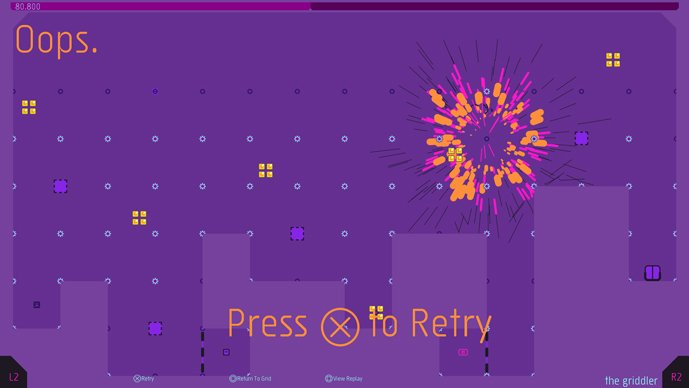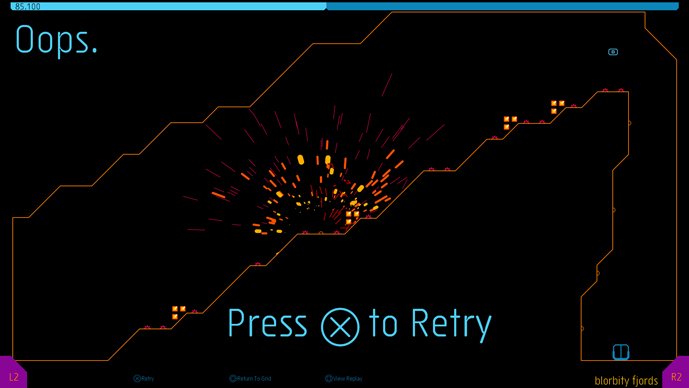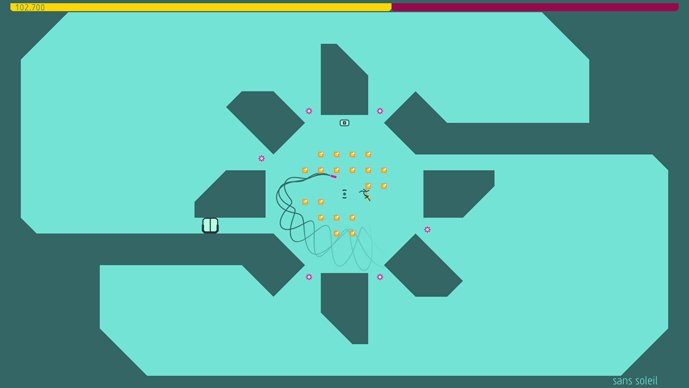At GDC, Metanet’s Mare Sheppard gave a detailed talk on how she – and co-creator Raigan Burns – approach designing N++’s infamously tough levels.
Metanet created the hard-as-nails action puzzle platformer N back in 2004. Since then, N+ became an early Xbox Live Arcade hit and N++ was released last year, on PlayStation 4. Sheppard and Burns have been working on the series for twelve years, during which time they have created over 10,000 levels. The nature of N++, however, means that this hasn’t been as much of a slog as you might think.
“If there wasn’t so much potential variety, that would have gotten old really fast,” she says.
Underpinning this is N++’s fundamental game design, which is focused on the interconnectivity between the player and a variety of environmental elements.
“A game’s design is a set of rules and behaviours and relationships,” Sheppard says. “That implicitly defines all the things that can happen in the game.”
Sheppard sees designing levels as comprised of two things.
“Our job as level designers,” begins Sheppard, “is firstly to explore the huge possibility space that’s latent in the game’s design, so that we can discover various arrangement of elements that produce interesting experiences for players to engage with; and, secondly, to develop a deep understanding and knowledge of these elements and experiences so that we can combine them in unique ways and sustain a game experience.”
This is achieved despite N++’s simple rule set: three buttons controlling left and right movement, and the jump. The biggest, most obvious difference in comparison to other platformers is its movement model.
“The movement mode is why controlling the Ninja does not feel like controlling Mario,” explains Sheppard. “The Ninja has lot of inertia and it takes several seconds to change direction and to reach top speed. That makes it feel a lot more like a driving game as you are constantly adjusting your velocity and developing a feel for the momentum. As a player you always have to anticipate the future state of the world, instead of relying on twitch reflexes.””
This explains why N+ and N++ feel unlike any other platforming games. The mechanics require learning and experience to master, and the model directly affects how the levels are created.
“In Super Mario Bros it’s your horizontal velocity that effects jump height, you can jump higher by running faster,” says Sheppard. “In N++ it’s your vertical velocity that determines jump height and – combined with wall jumping – this creates a feedback loop, where you can build a huge amount of upwards momentum if you time your jumps right.”
The tile-based design of the game also plays an important part, as Sheppard explains.
“In most platformers there are usually three types of surface your character can move around on: horizontal, vertical and 45 degree angles. But we wanted to build on that foundation and open up some new movement possibilities. So we added 22.5 degree and 67.5 degree angels and curved surfaces. This gives more opportunities for acrobatics and for gaining and conserving speed. They give us more tools for creating interesting shapes and nuanced environments.”
All of these elements combine to make N++ a tough game to play, with success often down to the smallest of margins. Movement in N++ is a performance that needs to learned and mastered.
“Our goal as designers is to have deep understanding of how to control the ninja, to teach the control to players and then provide a variety of different contexts and motivations so that players can apply what they’ve learned and test and expand the boundaries of their skills,” Sheppard says.
If movement and structure provide the foundation for the game, it’s the addition of enemies and objects that add the challenge. They fall into two types: static and passive, and each has its own way of motivating the player to keep moving. Drones, for example, generate different patterns and rhythms of available and unavailable space, while Toggle Mines and Clone Ninjas close off spaces you have previously used and affect available future paths.
“Each level is a mechanism controlled by the player and they move through it,” says Sheppard.

The basic progress of creating a level in N++ is one of build, test, refinement and re-test.
“The goal is to make each level as different from each other as is possible, to make the game interesting and varied.”
According to Sheppard, inspiration can come from many places; from architecture, geometry and shapes, from sketching and doodling, or even from a word or a name.
Also important is the general difficulty of a level, its length, the types of movement required and the combinations of enemies and objects. Burns and Sheppard also balance levels by changing their pacing and the skills required to complete them. For example, some levels are focused on having enormous patience, while others rely on using quick reflexes.
As development continues they play each other’s levels to provide feedback and refinements.
“It’s a really fun dynamic because you naturally want to impress or surprise the other person. We approach making levels as a collaboration and we pass things back and forth and talk about problems and potential,” explains Sheppard.
“The main focus of this review is to rank the difficulty and rate the quality of each level. The quality rating is a scale from zero to two and it’s based on the specialness of a level, how it stands out compared to the average.”
What makes a level special has developed over time and is a subjective, gut feel. It’s also important for the game that relatively ordinary levels are included too. They provide balance and make the special – or difficult – levels stand out.
“This approach led to our ‘tough but fair’ level design style,” says Sheppard. “We play through the levels so many times that anything that is overly frustrating or unfair get naturally smoothed out.”
But with the constant refinement Sheppard says that it’s hard to stop tweaking and adjusting, sometimes to the detriment of the finished product.
“Near the end of development we reviewed all the levels and realised that a lot of that beautiful simplicity that we love so much had totally been lost. It wasn’t very minimal anymore – which is something we love – because we just messed with them too much.”
The archive and level editing tools came to the rescue and Sheppard and Burns made a case-by-case decision on whether to revert or review each level. This exercise actually turned out to pay dividends, helping inspire the game’s secret levels.
The final step in the design process is in the naming of a level. The series is noted for it’s humourouly appropriate level names which add another dimension to the game. Sheppard cites a prime example: Bullshit Mountain.
“It’s unique and silly but also indicates what to expect to the player,” she says. “But it hopefully undercuts the frustrations the player might feel with a little bit of levity.”

“Level design is a little bit like cooking,” says Sheppard. “You have to constantly taste the food to know how it’s coming together, but that also makes you get used to the flavour. We’ve been playing this game for more than ten years and this makes it really hard for us to keep an objective perspective on the difficulty of each level.”
Balancing the game’s difficulty requires a lot of attention, but Sheppard is pleased that the series is noted for how challenging it is.
“We try to be sympathetic to the player but at the same time want to challenge them as much as possible,” she says. “Ultimately we want them to feel proud of their hard-earned skill. N++ is a tough game but what’s fun about it is how satisfying it feels to get through the challenge you’re up against.”
To accommodate players of different skills and techniques a number of routes are added to many levels. Some are safer but offer less in the way of reward, while others are harder but offer the game’s gold currency in plentiful supply.
“Doing this lets players moderate the difficulty themselves in an organic way and they feel empowered. We feel that’s a big part of game design,” Sheppard says.
N++ also introduces the aforementioned secret levels to the series. These levels were inspired by Super Mario World, and subvert what the player has learned, using variations that didn’t make it into the main game.
“The new stuff we were doing was really exciting, just a little weird. Making secret levels was a way of taking these weird offshoots, to push them even further and give them a place in the game that felt like it fit and didn’t feel gimmicky.”
With over 2,000 levels in the game, repetition is unavoidable but, as Sheppard explains, it’s also something to embrace.
“Our philosophy is that levels are a conversation you are having with the player. We want that conversation to be playful, interesting, constructive and loose, and never dull or mean. N++ is really difficult: if it was unfair, or took cheap shots, it would be infuriating. And this is where repetition in level design can be really helpful. If players can learn without being constantly frustrated it allows them to recognise situations they’ve been in before and apply the skills they have learned.”

Sheppard concludes by explaining how N++ balances all of these aspects to create a satisfying and stimulating gameplay experience.
“Part of the challenge of playing N++ is that players need to be responsive to the demands of the level on the fly and develop the skill of reading the level and seeing what’s possible. We feel that when engaging at this higher level, contextual awareness is just as important as the basic muscle memory reflex skills, so that all parts of the brain are engaged and learning.”
N++ Available on now PlayStation 4 and will be released on Steam later this year.






